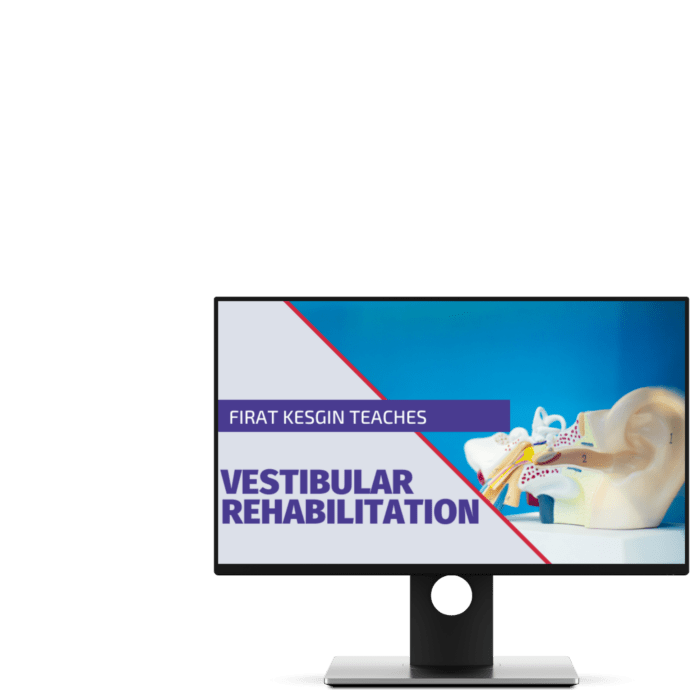Cervicogenic Dizziness | Diagnosis & Treatment

Cervicogenic Dizziness | Diagnosis & Treatment
Introduction & Pathophysiology
Cervicogenic dizziness is defined as “a non-specific sensation of altered orientation in space and disequilibrium” and it is related to neck dysfunction. It is more frequently present in females and in people with sitting jobs or in those with sustained neck positions during work. The dizziness complaint is often more a sensation of lightheadedness in combination with disequilibrium.

Pathomechanism
Cervicogenic dizziness is caused by a sensory mismatch of the afferent information of the neck. Important proprioceptive structures like muscle spindles and nerve receptor endings are located in the neck. Therefore, this region is important for postural control and balance. Due to a cervical dysfunction (originating from a mechanical, degenerative or inflammatory disorder), a sensory mismatch of the afferent cervical proprioceptive input with sensory input from the visual and vestibular system occurs. This abnormal afferent input from cervical joint receptors/mechanoreceptors to the vestibular nucleus causes a mismatch with the information from the vestibular and visual systems.
Triggers may be:
- (Quick) neck movements, for example, neck extension when looking up
- Reduced ROM of the neck
- Neck pain
- Certain (sustained) neck positions
Follow a course
- Learn from wherever, whenever, and at your own pace
- Interactive online courses from an award-winning team
- CEU/CPD accreditation in the Netherlands, Belgium, US & UK
Clinical Picture & Examination
Signs and symptoms
In the history taking, it becomes clear that the patient has co-existing neck symptoms. The cervicogenic dizziness develops gradually, is episodic and can last several minutes to hours. Movements of the head and neck reproduce the dizziness symptoms. Typically, the dizziness is non-rotatory, but rather a sensation of disorientation, lightheadedness, or disequilibrium that is accompanied by neck pain, reduced neck ROM and balance.
Examination
Importantly, cervicogenic dizzines is a diagnosis of exclusion. This means that first other central and vestibular causes of dizziness should be excluded.
During inspection, forward head posture, greater shoulder protraction, and a “slouched” posture may be observable. Though these positions are generally not pathological, they may alter the loads in the neck and shoulder girdle due to altered muscle functioning. Palpation may reveal muscle soreness and a feeling of tightness upon palpation of the neck and shoulder girdle muscles.
Active examination
Measurement of active neck range of motion to determine the need for cervical joint mobilization.
Joint position sense should be assessed. A study by De Vestel et al. in 2022 found that patients with cervicogenic dizziness had larger errors with the joint position sense test upon neck extension.
Measures of balance could include static balance for example in tandem stance and dynamic balance during for example the Timed-up and Go-test, tandem gait or functional Gait Assessment. It was found that larger joint position sense error, a high score on the Neck Bournemouth Questionnaire and better Tandem Gait scores were associated with higher odds of having cervicogenic dizziness.
Passive examination
Palpation of the neck can reveal tenderness in the suboccipital region. Palpation of the cervical transverse processes of C1 and C2, spinous processes of C2 and C3 may reveal local or spreading pain or may provoke the sensation of cervicogenic dizziness. Palpation of the levator scapulae, splenius, rectus, semispinalis and upper trapezius muscles can be done to evaluate the muscle tone.
To assess whether mobility of the upper and lower cervical spine and cervicothoracic junction is impaired and thus possibly underlying the cervicogenic dizziness, the following tests can be performed.
- Flexion-rotation test
- Direct upper cervical PIVMs in sitting postion
- Indirect upper cervical PIVMs in supine
- Direct mid cervical PIVMs in sitting postion
- Upper thoracic spine assessment in flexion and extension
Strength and endurance
To assess the strength and endurance, the following tests can be done.
- Cranio-cervical flexion test
- Test of Harris – Deep neck flexor endurance test
- Cervical extensor endurance test
Dizziness specific assessment
Certain specific tests can be done to evaluate cervicogenic dizziness
Follow a course
- Learn from wherever, whenever, and at your own pace
- Interactive online courses from an award-winning team
- CEU/CPD accreditation in the Netherlands, Belgium, US & UK
Treatment
Ideally, treatment should be targeted to the findings from the examination. Manual therapy with direct or indirect upper cervical PIVMs, cervical SNAGs can be used in case the examination reveals range of motion restrictions. A traction-manipulation of the cervical spine and/or the cervicothoracic junction may be performed to promote the positive neurophysiological effects
Strengthening and endurance should be performed to enhance strength of the upper cervical spine. Deep neck flexor and extensor exercises are easy to perform and can be done easily at home or work.
Sensorimotor training should be incorporated when the examination reveals errors in joint position sense, difficulties with eye movement control, and postural balance.
- Proprioception/joint position sense exercises
- Oculomotor exercises
- Postural stability balance training
References
Follow a course
- Learn from wherever, whenever, and at your own pace
- Interactive online courses from an award-winning team
- CEU/CPD accreditation in the Netherlands, Belgium, US & UK
How to Master Treating Patients with Dizziness & Vertigo


What customers have to say about this online course
- Marlies Wouters30/12/24vestibulaire revalidatie Duidelijke, praktische en uitgebreide cursusMichael de Beer12/12/24complete en really practical couse erg praktische cursus waarvan de stof zeer goed toepasbaar is in de dagelijkse praktijk. Docent Firat heeft ontzettend veel kennis. Ik zou fysio- manueeltherapeuten die interesse hebben in duizeligheid deze cursus 100% aanbevelen.
- Daan26/11/24Uitgebreide up tot date cursus over duizeligheid Super online cursus op het gebied van duizeligheid. Veelzijdig en geschikt voor de dagelijkse praktijk.Jasper Vanderheyden10/10/24Great course Really great course. I learned a lot more about vestibular problems. Not the easiest topic, but really interesting.
- Annemieke Posthouwer29/04/24Vestibular Rehabilitation VESTIBULAIRE REVALIDATIE
Very goodBieke van Erve-Merkx19/04/24Vestibular Rehabilitation FANTASTIC
Best course ever!
Clear and practical information. High recommandation! Firat is a good speaker and translates it very nicely into practice. - Aleksandar Antic29/02/24Vestibular Rehabilitation BEST VESTIBULAR COURSE
Absolutely great course, showing all detailed insights over the Vestibular Rehab.
I would recommend anyone to avail the same knowledge from Physiotutors.Andrea Johnson24/10/23Vestibular Rehabilitation GREAT COURSE
This course is super informative and detailed. I have learned a ton and feel confident in beginning to assess and treat vestibular clients. - Mads Louis25/11/22Vestibular Rehabilitation EXCELLENT COURSE, THAT MAKES YOU READY TO TREAT DIZZINESS WITH CONFIDENCE
This course provides an excellent opportunity to learn how to treat and diagnose vertigo/dizziness patients, who previously were a mystery to treat.Andreas Johnson24/10/22Vestibular Rehabilitation GREAT COURSE
This course is super informative and detailed. I have learned a ton and feel confident in beginning to assess and treat vestibular clients. - Jordi Holierhoek18/08/22Vestibular Rehabilitation EXCELLENT COURSE!
Fantastic course, very practical with enough depth! I learned a lot from first. He is an excellent teacher who knows his stuff. I would totally recommend this course.Stephen08/08/22Vestibular Rehabilitation GREAT COURSE FOR BEGINNERS AND THERAPISTS WITH SOME EXPERIENCE
Loved the course, can be done relatively quickly if you are like me and have a little bit of vestibular knowledge (it took me around 2 weeks), but the basics are all there so you can spend a bit more time getting into it if needed
I luckily had two patients in my ward needing vestibular rehabilitation just as I had finished this course, and I was able to help them straight away - Kim Hansen30/03/22Vestibular Rehabilitation VESTIBULAR REHABILITATION
Really good and professional layout with Firat's professional experience as well as nice software touches by Physiotutors with questions in some videos for example. Firat approaches you in different ways of teaching with small videos, summaries, lectures and so on. Also fun to see that some of his references are people that I have a cooperation with here in Sweden. Even if there’s a whole division of information regarding vestibular hypofunction it would still be fun to have separate chapter for vestibular neuritis, but that’s just a small note. On the whole I’m totally happy and satisfied with this course, really good job done by Firat and Physiotutors, I will be keeping an eye out for more advanced courses in the future regarding this topic, maybe Firat can do a Masterclass version?Steve van Rijen26/03/22Vestibular Rehabilitation VESTIBULAR REHABILITATION
By far the best course i ever had.
It will take you a lot of time and effort to make it your own.
But i can tell, the reward is great.
you won’t be disappointed - Marine Gandin27/01/22Vestibular Rehabilitation REALLY COMPLETE COURSE AND EASY TO LEARN
It takes me 6 full days to finish that course but it was a really good course!
I enjoyed every part of the “vestibular rehabilitation” by Firat.
I’m excited to start doing some practice with patient!
I didn’t need any further explanation but I saw that Firat answers very fast to the question on the unit.
Thank you very much for this amazing course!
Even if it is in an other language than mine, it was really easy to understand.
Thanks!Christiena den Tek28/12/21Vestibular Rehab COMPLETE COURSE ABOUT DIZZINESS AND THE WAY TO TREAT FOR PHYSIO'S
In the past I finished/followed a few courses about dizziness and treatment. I really enjoyed following this course because it’s very complete. There is overall information about the systems involved with dizziness problems, the pathologies, the exams and the overall physiotherapy treatment or other treatments. There is a nice mix between the way the information is given and the information is up to date science. The teacher (Firat) is a teacher that loves helping you out and if you have any questions he is quickly in his response.
I would recommened this course highly not only for those who just start learning things about the dizziness (patient) but also for those who are already working with these patients. - Elisabetta12/12/21Vestibular Rehabilitation INCREDIBLY THOROUGH COURSE
Such a fantastic course!
The learning experience is enhanced by interactive material found in each module.
The instructor provides clear information, both theoretical and practical, easy to apply in clinical practice.
This is an excellent course, and I would definitely recommend it!Physiotutors27/08/21Vestibular Rehabilitation Firat really delivered on this course! While we have had some training in vestibular diagnostics and rehab in our own training, this course is on a whole other level! Building this course with Firat has increased our knowledge dramatically and we can absolutely recommend this course to any Physiotherapist as patients with vestibular problems will be among the most grateful patients when treated right. - Anne Cahill02/08/21Vestibular Rehabilitation Thank You!!
This is a brilliant course. The learning materials are concise, clear and comprehensive. All the information given is easy to navigate, up to date and very useful for daily clinical vestibular rehabilitation practice. It is a much appreciated educational resource. Amazing!! Thank you for this excellent course.Astrid Schubart27/06/21Vestibular Rehabilitation I finished this course Vertigo this weekend and it’s been a long time since I’ve done such a great structured training. Lots of practical content. The lecturer shows in detail what is important. Firat Kesgin offers a lot of additional information and patient information.
I am really excited and looking forward to apply my new knowledge in practice.







